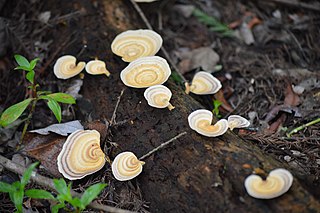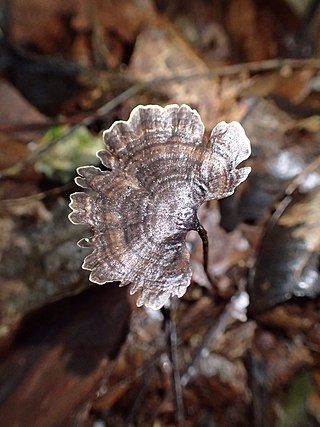Related Research Articles

Tyromyces chioneus, commonly known as the white cheese polypore, is a species of polypore fungus. A widely distributed fungus, it has a circumpolar distribution, in temperate boreal pine forests, of Asia, Europe, and North America, causes white rot in dead hardwood trees, especially birch.

Meripilus giganteus is a polypore fungus in the family Meripilaceae. It causes a white rot in various types of broadleaved trees, particularly beech (Fagus), but also Abies, Picea, Pinus, Quercus and Ulmus species. This bracket fungus, commonly known as the giant polypore or black-staining polypore, is often found in large clumps at the base of trees, although fruiting bodies are sometimes found some distance away from the trunk, parasitizing the roots. M. giganteus has a circumboreal distribution in the northern Hemisphere, and is widely distributed in Europe. In the field, it is recognizable by the large, multi-capped fruiting body, as well as its pore surface that quickly darkens black when bruised or injured.

Antrodiella is a genus of fungi in the family Steccherinaceae of the order Polyporales.

Bjerkandera is a genus of wood-rotting fungi in the family Meruliaceae.

Microporellus is a genus of poroid fungi in the family Polyporaceae.

Nigroporus is a genus of poroid fungi in the family Steccherinaceae. The genus was circumscribed by American mycologist William Alphonso Murrill in 1905. Nigroporus has a pantropical distribution. The genus name combines the Latin word niger ("black") with the Ancient Greek word πόρος ("pore").

Skeletocutis is a genus of about 40 species of poroid fungi in the family Polyporaceae. The genus has a cosmopolitan distribution, although most species are found in the Northern Hemisphere. It causes a white rot in a diverse array of woody substrates, and the fruit bodies grow as a crust on the surface of the decaying wood. Sometimes the edges of the crust are turned outward to form rudimentary bracket-like caps.

Tyromyces is a genus of poroid fungi in the family Polyporaceae. It was circumscribed by mycologist Petter Karsten in 1881. The type species is the widely distributed Tyromyces chioneus, commonly known as the white cheese polypore. The phylogenetic position of Tyromyces within the Polyporales is uncertain, but it appears that it does not belong to the "core polyporoid clade". Tyromyces is polyphyletic as it is currently circumscribed, and has been described as "a dumping place for monomitic white-rot species with thin-walled spores."
Atraporiella is a monotypic fungal genus in the family Steccherinaceae. It contains the crust fungus Atraporiella neotropica, known only from Belize.

Metuloidea is a genus of five species of fungi in the family Steccherinaceae. The genus was circumscribed by New Zealand-based mycologist Gordon Herriot Cunningham in 1965. The type species is M. tawa, a fungus originally described by Cunningham as a species of Trametes. Formerly classified in family Meruliaceae, Metuloidea was moved to the Steccherinaceae in 2016, following prior research that outlined a revised framework for the Steccherinaceae based on molecular phylogenetics.
Metuloidea murashkinskyi is a species of tooth fungus in the family Steccherinaceae. It is found in Europe and Asia, where it causes a white rot on the wood of deciduous trees.
Rickiopora is a fungal genus of unknown familial placement in the order Polyporales. The genus is monotypic, containing the single neotropical species Rickiopora latemarginata.

Loweomyces fractipes is a species of poroid fungus in the family Steccherinaceae, and the type species of the genus Loweomyces. It is a widely distributed species, found in North America, Europe, Central America, South America, and Korea.
Butyrea is a genus of two species of crust fungi in the family Steccherinaceae.
Nigroporus macroporus is a species of poroid fungus in the family Steccherinaceae. It was described as new to science in 2003 by mycologists Leif Ryvarden and Teresa Iturriaga. Found in Venezuela and Brazil, it is a wood-decay fungus that causes a white rot in the hardwood Dimorphandra macrostachya.
Mycorrhaphium citrinum is a species of tooth fungus in the family Steccherinaceae that is found in Africa. It was described as a new species in 1989 by Norwegian mycologist Leif Ryvarden. The type collection was made in Chati, a region in the Copperbelt Province in Zambia, where it was found growing in leaf litter.
Mycorrhaphium africanum is a species of tooth fungus in the family Steccherinaceae. It was described as new to science in 2003 by mycologists Dominique Claude Mossebo and Leif Ryvarden. The type was collected in the Dja Faunal Reserve in Cameroon, where it was found fruiting on fallen dead hardwood branches.
Antella niemelaei is a species of poroid crust fungus in the family Steccherinaceae.
Daedalea ryvardeniana is a neotropical species of poroid fungus in the family Fomitopsidaceae. Found in Brazil, it was described as new to science in 2012.

Perenniporia stipitata is a species of poroid fungus in the family Polyporaceae. Found in Brazil, it was described as a new species in 1987 by Norwegian mycologist Leif Ryvarden.
References
- 1 2 Ryvarden, L. (1987). "New and noteworthy polypores from tropical America". Mycotaxon. 28 (2): 525–541 (see p. 532).
- ↑ Ryvarden, Leif; de Meijer, A.A.R. (2002). "Studies in neotropical polypores 14. New species from the state of Paraná, Brazil". Synopsis Fungorum. 15: 34–69.
- ↑ Robledo, Gerardo; Gugliotta, Adriana de Mello (2013). "New distribution record of Nigrohydnum nigrum Ryvarden (Polyporales: Basidiomycota) in the Atlantic forest". Check List. 9 (1): 97–98. doi: 10.15560/9.1.97 . hdl: 11336/81968 .